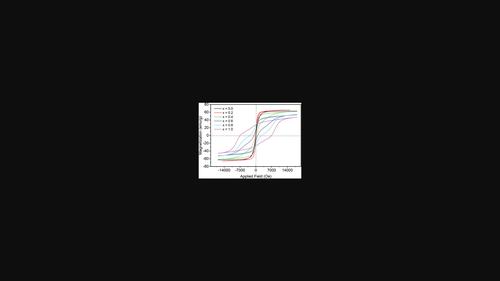Strain and Exchange-Spring Mechanism of (1-x) Ni0.5Cu0.25Zn0.25Fe2O4 + (x) SrFe11Y1O19 Magnetically Soft–Hard Ferrite Composed Nanoparticles
IF 2.7
4区 材料科学
Q3 CHEMISTRY, PHYSICAL
引用次数: 0
Abstract
A mixture of soft–hard (S–H) ferrites with the general chemical formula (1-x) Ni0.5Cu0.25Zn0.25Fe2O4 (NCZFO) + (x) SrFe11Y1O19 (SFYO) is developed via sol-gel auto-combustion and their physical mixing. X-ray diffraction (XRD), Fourier transform infrared spectroscopy, field emission scanning electron microscopy (SEM) coupled with energy dispersive X-ray spectroscopy, high-resolution transmission electron microscopy (HRTEM), vibrating sample magnetometry (VSM) and two-probe technique are used to examine the resultant materials. Rietveld refinement of XRD data confirms the co-existence of both soft and hard phases in the composites. The HRTEM and FESEM results confirm the nanocrystalline nature of the synthesized particles. Williamson-Hall method is employed to reveal the strain nature in soft and hard phases. VSM analysis shows considerable changes in the magnetic characteristics for the different composition of NCZFO and SFYO. The exchange-spring mechanism is discussed in the manuscript.

(1-x) Ni0.5Cu0.25Zn0.25Fe2O4 + (x) SrFe11Y1O19 磁性软硬铁氧体复合纳米粒子的应变和交换弹簧机制
通过溶胶-凝胶自动燃烧和物理混合,研制出了一种化学通式为 (1-x) Ni0.5Cu0.25Zn0.25Fe2O4 (NCZFO) + (x) SrFe11Y1O19 (SFYO) 的软硬(S-H)铁氧体混合物。X 射线衍射 (XRD)、傅立叶变换红外光谱、场发射扫描电子显微镜 (SEM) 和能量色散 X 射线光谱、高分辨率透射电子显微镜 (HRTEM)、振动样品磁力计 (VSM) 和双探针技术被用来检测生成的材料。对 XRD 数据进行的里特维尔德细化证实了复合材料中软相和硬相的共存。HRTEM 和 FESEM 结果证实了合成颗粒的纳米结晶性质。威廉姆森-霍尔法揭示了软相和硬相中的应变性质。VSM 分析表明,不同成分的 NCZFO 和 SFYO 的磁特性发生了很大变化。手稿中讨论了交换弹簧机制。
本文章由计算机程序翻译,如有差异,请以英文原文为准。
求助全文
约1分钟内获得全文
求助全文
来源期刊

Particle & Particle Systems Characterization
工程技术-材料科学:表征与测试
CiteScore
5.50
自引率
0.00%
发文量
114
审稿时长
3.0 months
期刊介绍:
Particle & Particle Systems Characterization is an international, peer-reviewed, interdisciplinary journal focusing on all aspects of particle research. The journal joined the Advanced Materials family of journals in 2013. Particle has an impact factor of 4.194 (2018 Journal Impact Factor, Journal Citation Reports (Clarivate Analytics, 2019)).
Topics covered include the synthesis, characterization, and application of particles in a variety of systems and devices.
Particle covers nanotubes, fullerenes, micelles and alloy clusters, organic and inorganic materials, polymers, quantum dots, 2D materials, proteins, and other molecular biological systems.
Particle Systems include those in biomedicine, catalysis, energy-storage materials, environmental science, micro/nano-electromechanical systems, micro/nano-fluidics, molecular electronics, photonics, sensing, and others.
Characterization methods include microscopy, spectroscopy, electrochemical, diffraction, magnetic, and scattering techniques.
 求助内容:
求助内容: 应助结果提醒方式:
应助结果提醒方式:


